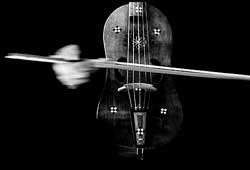
|
The fiddle (German: fidel) is an instrument that most likely derived from Arab stringed instruments (rabab). It can be shown to have existed in Europe possibly as early as the 9th and with certainty in the 11th century. After arriving it Spain, it quickly spread to the rest of Europe. The most frequent forms were elliptical or guitar- shaped. In contrast to the modern violin, the back and the belly were always flat. While the earliest instruments were made from a single piece of wood (with the belly glued on), they were later made of individual parts with a separate back and belly that were connected with ribs. The strings were attached to a peg-disk that was often heart-shaped and frequently expanded to a peg-box that was turned back and fitted with lateral pegs. The number of strings varied between two and five. The material used for the strings also varied considerably: various kinds of animal gut, horse-hair, bronze, gold and even silk. From earliest times there must have been several ways of holding and playing the instrument. But in pictorial material and in sculpture (notably the Portico della Gloria in Santiago de Compostela) they can be seen held on the knees or transversely across the abdomen, supported by the shoulder, and played with a bow or plucked with the fingers. |
|||||||